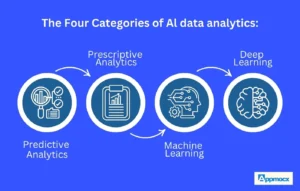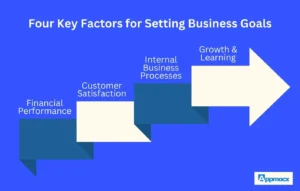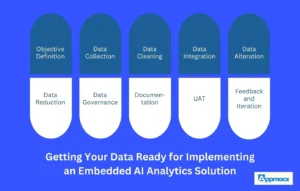AI Data Analytics- What is it?
The field of Artificial Intelligence (AI) includes a variety of functions and features to explore and utilize effectively in areas of use cases such, as AI driven tools that are powered by machine learning techniques which have a significant impact on numerous business operations where data analytics stands out as a key player in driving success for enterprises.
Using AI for data analysis focuses on utilizing AI technologies, like machine learning algorithms to analyze complex data sets efficiently and gain valuable insights from large volumes of data sources automatically. By automating tasks such as identifying patterns in the data and predicting outcomes accurately with human intervention these AI powered analytical tools are transforming how businesses manage and leverage their data resources.
AI data analytics can be divided into several distinct categories:

- Predictive Analytics: Using historical data to predict outcomes and understand customer actions and market trends is what predictive analytics is all, about
- Prescriptive Analytics: Providing advice based on data analysis to assist businesses in making informed decisions.
- Machine Learning: Empowering systems to enhance and fine tune analyses by adapting to data inputs without requiring manual programming adjustments.
- Deep Learning: Utilizing neural networks to understand and analyze intricate data formats, like images and audio.
Businesses benefit greatly from AI data analytics due, to its capability to efficiently and accurately process varied datasets giving them an edge through leveraging information effectively.
How Businesses Are Harnessing Artificial Intelligence and Machine Learning for Analytics
AI powered analytics software found in SAP products is revolutionizing how businesses operate by providing insights seamlessly integrated into workflows. These tools enable companies to make informed choices in sectors while keeping tabs on key performance indicators and reacting promptly— all without the hassle of switching between different systems.
The uses of these tools differ depending on the industry and company. Serve a goal, in various sectors like retail and manufacturing or logistics by tailoring shopping experiences based on customer behavior and purchase history and optimizing maintenance schedules to reduce costs and improve efficiency in operations such as route planning while ensuring compliance with regulations for risk management purposes in the financial sector as well as improving supply chain visibility, for better inventory management in anticipation of any potential disruptions.
In the field of HR embedded analytics are used to analyze data about the workforce to make decisions regarding performance evaluation of employees and their retention strategies besides focusing on talent development within the organization’s framework and business objectives in line with environmental sustainability goals by monitoring ecological impact and assisting companies in adapting their practices.
Can AI Replace Data Analysts?
According to a study findings show that 77 percent of people are worried about AI taking over jobs however the World Economic Forum anticipates that AI will create 97 million new job opportunities instead of displacing workers altogether as it reshapes the landscape of employment just like past technological advancements have done in the past.
The advancement of AI technology has caused a lot of worry, among workers as it can automate tasks and uncover hidden patterns using learning techniques to make decisions swiftly and handle large volumes of data effectively while accomplishing intricate tasks in mere seconds as well surpass human abilities in numerous areas. Making data analysts irrelevant AI tools are projected to reshape their responsibilities by improving their effectiveness, in processing and presenting data.
AI powered data analysis tools currently lack the ability to replicate expertise in issue solving and strategic decision making tasks entirely efficiently yet they are prone to making elementary errors that necessitate human supervision. Therefore analysts dealing with data should regard AI as an instrument to enhance their skills than a substitute.
AI excels in handling datasets and streamlining tasks like analyzing data and creating reports efficiently. By taking care of these duties AI frees up analysts to concentrate on valuable tasks that require human intuition such as interpreting contextual data and making nuanced decisions.
The concerns, about AI taking over the roles of data analysts seem to be exaggerated and not entirely warranted as per a survey conducted recently among Managed Service Provider (MSP) participants showed that a majority believe that AI integration will not have effects on job opportunities; in fact some are even optimistic about growth in the field. Moreover! According to the U.S Bureau of Labor Statistics projections for 2022 and 2023 indicate a 23 percent rise in positions for Operations Research Analysts and a 13 percent increase in roles for Market Analysts.
The rise of AI tools is poised to transform the responsibilities of data analysts stay essential to their employers needs analysts need to grasp the skill of utilizing AI technology. By embracing these progressions and depending on AI for handling tasks data analysts can. Uphold their significance in a changing technological environment.
Leveraging AI Data Analytics Tools to Uncover Actionable Insights for Boosting Revenue
The worldwide market for AI is projected to increase at a growth rate of 36% spanning from 2024 to 2030. This swift uptake suggests that AI technologies are set to become a norm, in the business landscape companies that overlook this trend face the possibility of falling behind the competition. Nevertheless! Amidst this mounting pressure to incorporate AI into business practices swiftly lies the importance of pausing and devising strategies before committing to any investments.
The realm of intelligence includes a variety of tools tailored for tasks necessitating a careful and well planned selection and utilization process.I’ve heard that studies indicate that businesses that strategically expand their AI systems enjoy triple the return, on investment in comparison, to those who simply test out projects. This underscores the benefit of embracing a unified and all encompassing AI strategy throughout different sectors and operations rather than just depending on separate and unconnected trials.
In order to successfully integrate an AI system into operations it is crucial to strategize on how its functions can improve frameworks and business analytics procedures.
When planning for AI analysis tools implementation in your business strategy the initial step involves outlining how these tools will be integrated and choosing solutions that closely match your goals.
Set Clear Objectives for Your Business
Harvard Business School highlights four key factors that businesses should take into account when setting goals. These factors can be summarized as follows:

- Financial Performance: Make sure that the financial performance aligns with the business objectives and profit strategies while also meeting the budget plans to assess the worth and meet investor expectations effectively.
- Customer Satisfaction: In business it is important to focus on understanding and improving customer experiences to ensure their satisfaction.
- Internal Business Processes: Optimizing business procedures is crucial for enhancing operations across functions like administration and compliance to ensure the overall well being of the company.
- Learning and Growth: Concentrate on nurturing talent development and enhancing information systems while fostering a culture to establish a dynamic work environment that fosters creativity and progress.
Consider these factors when setting goals without using AI data analytics; however, choices made without understanding may not lead to the best outcomes. Incorporating AI analysis tools into these procedures allows leaders to establish goals that consider external factors.
Here is how artificial intelligence can be used effectively in areas:
Financial Performance: Monitoring performance is crucial for businesses to track metrics, like revenue growth and profitability using analytics tools such as KPIs in real time; this enables them to predict future trends and adjust strategies accordingly by analyzing current market conditions and internal performance metrics with predictive models.
Customer Satisfaction: Businesses can gain insights, into customer behavior and preferences by examining customer data and feedback analysis carefully. Tools for analyzing data keep track of customer satisfaction levels and engagement at points of contact. These tools provide information on factors influencing customer loyalty and how to improve the customer experience to meet or surpass expectations.
Internal Business Processes: Utilizing analytics can help streamline operations and improve productivity within a companys processes by identifying bottlenecks and inefficiencies that require attention or enhancement areas through the analysis of data, from these processes.
Learning and Growth: The use of analytics is essential in assessing the effectiveness of training programs and initiatives for growth within organizations. By evaluating how these activities influence employee performance levels businesses gain insights into the value (ROI). Analytics also monitors the growth of employee skills. Guide decisions on training investments to match organizational objectives precisely.
Get Your Data Ready and Deploy an Embedded AI Analytics Solution
The effectiveness of your business analytics and decision making heavily relies on the precision of your data. A few mistakes or missing details in your data flow can result in reports that undermine the benefits of data informed decision making.
The ability of AI to handle amounts of data enables your analysis team to thoroughly assess all of your companys data sets and improve the thoroughness and accuracy of your reports. Nevertheless‚ an organized data pipeline that guarantees the accurate flow of data into your tools is essential, for maximizing the effectiveness of even the most advanced solutions.
Creating and setting up your solution is just as important as selecting the AI analytics tool for the job. Equally crucial is getting your data ready for use in the analytics tool since this step is essential for the success of your analytics projects. Working with a software implementation partner is an effective method to ensure that your data analytics endeavors will deliver maximum value!
When collaborating with a professional let me walk you through the steps involved in executing the plan:

- Objective Definition: Working closely with your team members and partners, in System Integration involves the process of outlining and improving business goals for data analysis to make sure they are in line with the objectives of the organization.
- Data Collection: Internal teams rely on their help to efficiently extract and collect data from sources.
- Data Cleaning: Utilizing tools and techniques offered by SI partners facilitates collaboration with your in house team to automate the detection and elimination of errors and duplicates in order to uphold data integrity.
- Data Integration: Data Integration specialists are responsible for managing the merging of information, from systems to establish a cohesive perspective.
- Data Transformation: Data Transformation involves the tweaking and enhancement of data to align it with the needs of tools so that its prepared for analysis.
- Data Reduction: SI partners use methods to simplify data and enhance its efficiency, in analytics tools.
- Data Governance: Data Governance involves creating and upholding structures to guarantee the efficient handling of data.
- Documentation: SI partners offer in depth documentation on procedures to guarantee compliance with industry norms and regulations.
- UAT: They oversee the user acceptance testing (or UAT) for the analytics tool, which involves troubleshooting and optimizing the analytics tool to assess how well it works and how effective it is, in practice.
- Feedback and Iteration: SI partners carefully review testing feedback to adjust processes and implement improvements, for enhancement purposes.
Develop workflows that utilize valuable insights to promote data-driven decision-making
Established data understanding is essential for leveraging AI driven knowledge in a companys operations. A lack of data maturity within a company typically suggests that its employees and leadership do not fully appreciate the importance of data. Conversely a high level of data maturity indicates that a business actively collects and leverages data to enhance its processes. Organizations can enhance their data maturity by adopting strategies and promoting behaviors that maximize the utilization of data assets. However, 37 percent of decision makers think that their companies data maturity is at the best possible level.
To enhance your companys data expertise level you should create a system that merges data findings into your decision making procedures smoothly. Your technology implementation collaborator will help set up the framework for data focused analysis. They will improve the procedures for collecting and processing data to guarantee that the information utilized in analysis is precise and timely. This might entail automating data entry and enforcing standards for data quality control. Your partner will work together with your team to enhance these models according to the feedback and performance metrics provided by them simultaneously.They will also create personalized dashboards for showcasing data insights in a manner. Providing specialized training to ensure that all relevant staff members are capable of utilizing the new tool efficiently and interpreting its results effectively.
After setting up these tools in your system’s workflow process, the subsequent action involves merging data insights into your strategic planning procedures. On top of that, utilize the capabilities of the tool to steer strategies and propose adjustments to current plans.This way ensures that day to day operational activities are in sync with the business objectives.
Our goal is to create an environment that values and recognizes the importance of making decisions based on data analysis, which may involve giving credit and incentives to teams or individuals that effectively leverage data to drive advancements and creativity.
Track the Effects of Your Decisions Using Analytical Tools
It might be an good idea to set up a team or group to monitor how your AI system is being used and what effects its having within your organization. These folks should meet up regularly to check out the information provided by the AI system and make sure its being used effectively in the day to day operations of the company. They can also push for training sessions centered around AI and data analysis to help everyone in the organization understand and use these tools better for a data focused culture.
Create a structure to gauge the return on investment (ROI) of your AI projects by keeping an eye on indicators like how well your operations run in terms of efficiency and any money saved or earned due to AI implementation, alongside customer happiness and other key performance indicators (KPIs) that match up with your business objectives. Setting up these standards will enable you to measure the value that AI brings to your companys achievements and monitor how it affects results.
Utilize the knowledge gained from observing and assessing your AI system to create and execute strategies company wide. The committee responsible for reviewing data can play a role in spreading these methods and accomplishments promoting a consistent method for using data efficiently and implementing AI in different sectors within the organization.
You may also want to create a feedback loop with your service provider to improve the AI solution by incorporating data insights and ROI assessments into the process. Adjusting algorithms and expanding data sources as needed to boost performance and address any areas requiring attention for results.
Boosting Revenue Through AI-Powered Data Analytics
By using AI technologies like machine learning tools in operations businesses can analyze data sets with ease, automate pattern recognition tasks predict future outcomes accurately and make decisions more efficiently with less human intervention. Some important uses involve using analytics to predict customer behavior and leveraging learning techniques to understand complex data structures such as images.
Various sectors such as retail and manufacturing are integrating AI analytics to leverage data driven insights for efficiency and decision making processes. In the sector, for instance AI enhances customer experiences through the analysis of data while in manufacturing it optimizes logistics to reduce expenses.
The incorporation of AI is not aimed at substituting jobs but rather, at improving responsibilities and enabling professionals to concentrate on duties of repetitive tasks.. To enhance return on investment (ROI) companies should adopt AI in every aspect of operations.. To accomplish this goal necessitates establishing objectives and leveraging AI generated insights to achieve targets while partnering, with others to guarantee the quality of data is maintained..
Building a culture that values data driven decision making is crucial, for integrating workflows that make use of insights, from AI and consistently assessing the effects of AI implementation over time. This strategy empowers companies to effectively utilize AI capabilities to promote development and maintain an advantage.
When looking into a new analytics platform option start by investigating the process of selecting the software provider for implementation.